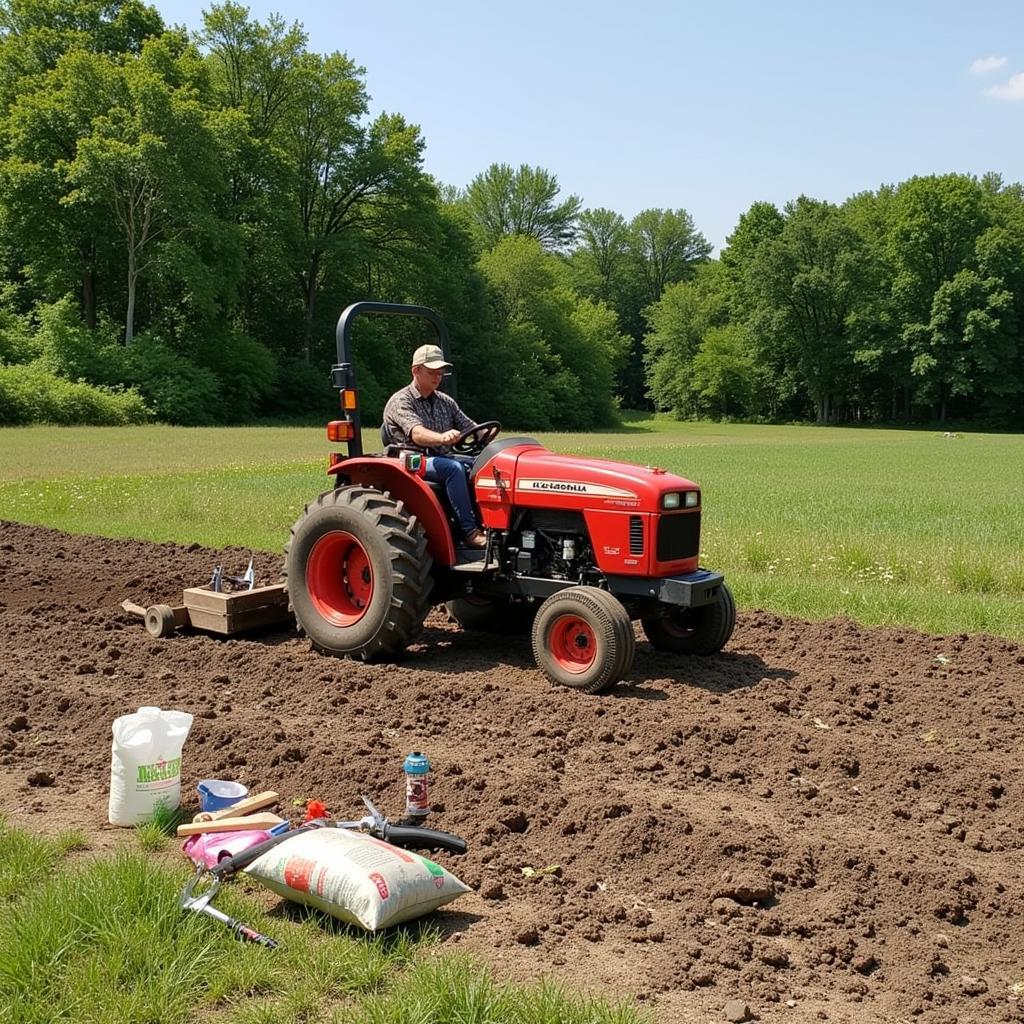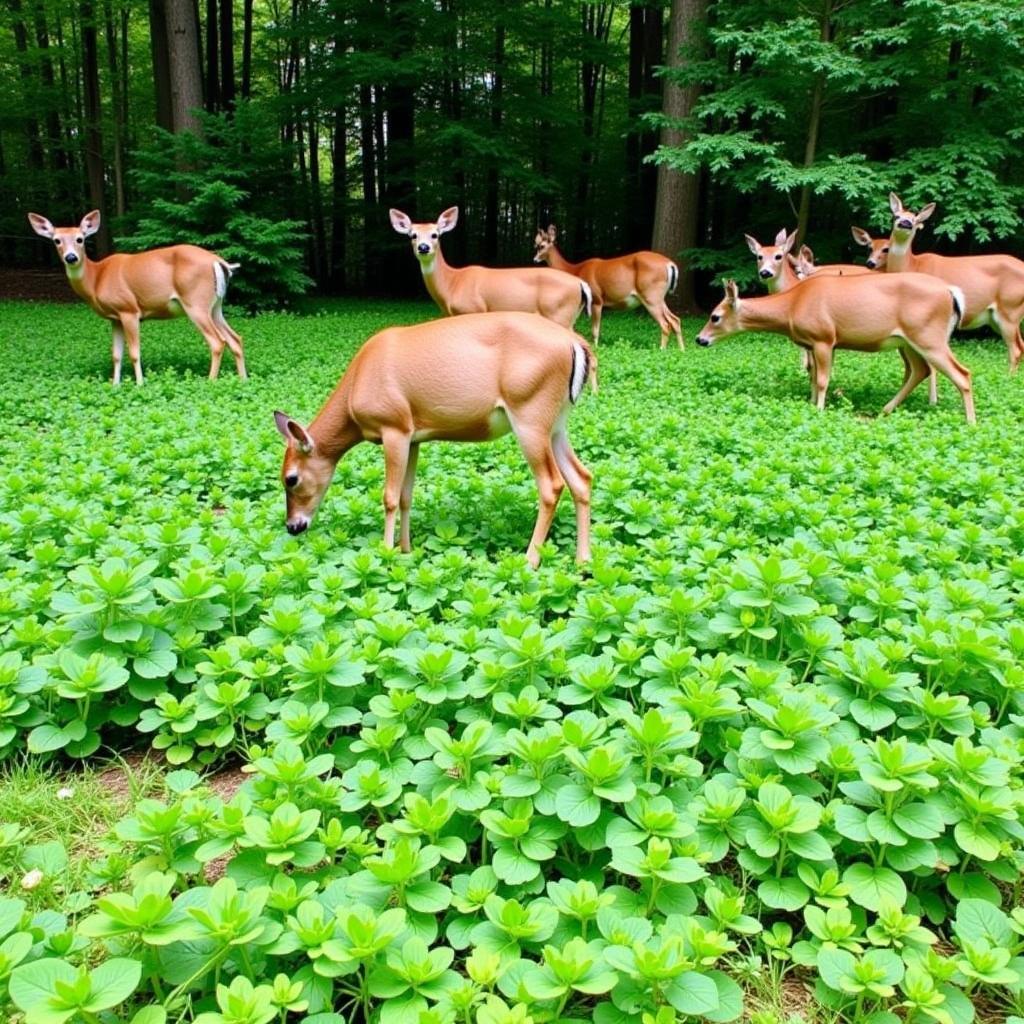Clover And Chicory Food Plots are a popular choice for hunters looking to attract deer and other wildlife to their property. These nutritious plants provide a valuable food source throughout much of the year, and when planted correctly, can thrive in a variety of climates. This guide will explore the benefits of using clover and chicory in your food plots, provide tips for successful planting, and help you understand why this combination is a winner for both wildlife and hunters. We’ll delve into the details of establishing and maintaining these plots, ensuring you’re well-equipped to create a thriving habitat.
Choosing the right seed mix is crucial for the success of your clover and chicory food plot. Consider factors like your local soil conditions, climate, and the specific wildlife you’re hoping to attract. Soil testing is a vital step to determine the pH level and nutrient content, allowing you to amend the soil accordingly for optimal plant growth. Correct soil preparation, including clearing existing vegetation and tilling the ground, creates the ideal seedbed for germination and establishment. Timing your planting to coincide with favorable weather conditions will further increase the chances of a thriving plot. You can achieve excellent results with a well-planned clover and chicory food plot, providing a reliable food source and attracting wildlife to your hunting grounds. Learn more about other perennial options for your plot at deer food plot perennials.
Why Choose Clover and Chicory?
Clover, with its high protein content, is excellent for antler growth and overall deer health. Chicory, a deep-rooted perennial, provides a palatable forage option even during dry periods. Together, they create a diverse and nutritious food source that deer will readily consume.
Benefits of Clover and Chicory
- Nutritional Value: The combination offers a balanced diet for deer, promoting healthy growth and attracting them to your property.
- Attractiveness: Deer find both clover and chicory highly palatable, making them an effective attractant.
- Drought Tolerance: Chicory’s deep roots help it withstand dry periods, ensuring a consistent food source.
- Ease of Establishment: Both plants are relatively easy to establish with proper soil preparation and planting techniques.
What are the advantages of incorporating sunflowers into your food plot strategy? Find out at sunflower seeds for food plots.
Planting Your Clover and Chicory Food Plot
Proper planting techniques are essential for establishing a healthy and productive food plot.
Step-by-Step Planting Guide
- Soil Test: Conduct a soil test to determine pH and nutrient levels.
- Soil Preparation: Clear existing vegetation and till the soil to create a suitable seedbed.
- Seeding: Broadcast the seed evenly according to the recommended rate.
- Covering the Seed: Lightly rake the soil to cover the seeds.
- Watering: Water the plot thoroughly after planting.
- Maintenance: Regular mowing may be necessary to control weeds and promote growth.
 Preparing a Clover and Chicory Food Plot
Preparing a Clover and Chicory Food Plot
Tips for Success
- Choose a sunny location with well-drained soil.
- Plant in the spring or fall for optimal germination.
- Use a seed drill or broadcaster for even distribution.
- Consider using a fertilizer specifically designed for food plots.
Maintaining Your Clover and Chicory Food Plot
Regular maintenance ensures your food plot remains healthy and productive.
Long-Term Care
- Weed Control: Regular mowing can help suppress weed growth.
- Fertilization: Apply fertilizer annually to replenish nutrients.
- Overseeding: Overseed as needed to maintain a dense stand of plants.
 Thriving Clover and Chicory Food Plot
Thriving Clover and Chicory Food Plot
“A well-maintained clover and chicory plot is like a magnet for deer,” says wildlife biologist, Dr. Sarah Miller. “It provides them with a consistent source of high-quality forage, crucial for their health and antler development.”
Maximizing Your Food Plot’s Potential
Consider incorporating other beneficial plants into your clover and chicory plot to further enhance its attractiveness and nutritional value. Adding plants like chicory and clover can significantly enhance your food plot. These additions create a more diverse and appealing food source for deer and other wildlife. Looking for a dedicated red clover plot? Learn more at red clover food plot.
Companion Planting
- Brassicas: Offer a late-season forage option.
- Grains: Provide additional carbohydrates and attract a wider range of wildlife.
“Diversifying your food plot with complementary plants ensures a continuous food supply throughout the year,” advises experienced hunter and outdoorsman, John Davis. “This keeps the deer coming back, providing more opportunities for observation and hunting.”
Conclusion
Clover and chicory food plots offer a highly effective way to attract deer and other wildlife to your property. By following these planting and maintenance tips, you can create a thriving food plot that provides a valuable food source and enhances your hunting experience. Creating a thriving food plot requires careful planning and execution. Consider a woods food plot for maximized benefits. Learn more at woods food plot. Remember, a successful clover and chicory food plot is a testament to your dedication to providing a healthy and attractive habitat for wildlife. Explore more resources on combined plots at chicory and clover food plots.
FAQ
- When is the best time to plant clover and chicory? Spring or fall are ideal for planting clover and chicory.
- How much seed should I use per acre? Seed rates vary, but generally, 6-8 lbs of clover and 2-3 lbs of chicory per acre are recommended.
- How do I control weeds in my food plot? Regular mowing and selective herbicides can help control weeds.
- Do I need to fertilize my clover and chicory food plot? Yes, annual fertilization helps maintain healthy plant growth.
- How often should I overseed my food plot? Overseeding every 2-3 years helps maintain a dense stand of plants.
- What other plants can I include in my food plot? Brassicas and grains are good companion plants for clover and chicory.
- How long does it take for clover and chicory to establish? Depending on conditions, it can take several weeks for the plants to establish.
Need assistance? Contact us at Phone Number: 02437655121, Email: [email protected] or visit our address: 3PGH+8R9, ĐT70A, thôn Trung, Bắc Từ Liêm, Hà Nội, Việt Nam. We have a 24/7 customer support team.